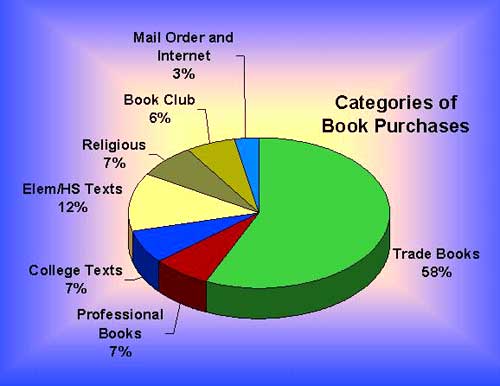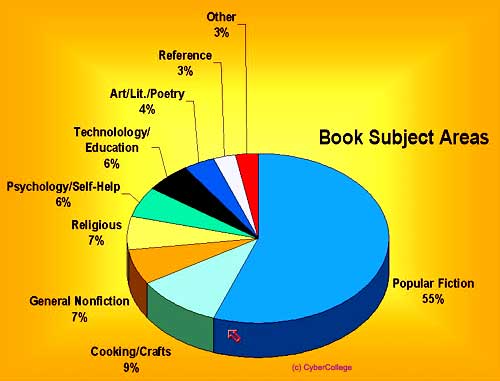The Print Media |

Books Part 1
The Early History
Although this may be an old joke, it does point to the fact that most Americans don't read even one book a year. It took one of the best-selling books of all time, Gone With the Wind, 40 years to sell 20 million copies. However, in a single evening more than 50 million people watched the movie on TV. A few books have had a major cultural influence. For example, Uncle Tom's Cabin helped turn attitudes against slavery in the United States, and Dr. Spock's Baby and Child Care influenced the rearing of a generation of children. The Bible remains the number one best seller of all time in the United States. This takes into consideration sales of the various translations over the last 100 years. Books are often used as sources for news stories, documentaries, and motion pictures. In this way, their influence goes far beyond bookstore sales. The chart above shows the breakdown of book sales by the traditional categories. Professional books include reference books used in areas such as business, law, medicine, and various technical professions. Trade books include a wide variety of books sold in stores, including the mass-market paperbacks. The chart below looks at book sales from the standpoint of subject areas. Note that popular fiction (mostly bestseller paperback books) leads all subject areas. Each week, periodicals such as the New York Times and the Los Angeles Times publish a list of the best-selling books. These two major lists differ in that they represent East and West Coast preferences, which can be quite different. The selection, production, and sales of books have all changed rather dramatically in recent years. But, to put these things into perspective we need to start at the beginning.
The earliest predecessors to books were the Sumerian clay tablets and the papyrus scrolls used about 2,500 BC, and the Papyrus Egyptian scrolls used in 600 B C. Plato's Republic is the oldest complete book that's been found. It dates back to 400 BC. The most notable example of scrolls were the Dead Sea Scrolls discovered in the 20th century, which provided new and sometimes controversial insights into traditional biblical writings. Until the printing press was invented, all written materials had to be hand copied--an arduous and time-consuming process. Until about the 12th century, most of the copying involved biblical scriptures and religious writings. Thousands of monks in European monasteries spent their entire lives copying these texts. Although most of the monks tried to faithfully stick to their original sources, evidence now indicates that errors were made, and occasionally the monks embellished the copies with their own views. Thus, when copies were subsequently made of the copies, the errors were compounded. Some biblical texts today list alternate versions of passages, if they are known. Because of the time-consuming copying process involved, these texts were limited in number and primarily available to the priests of the day. Around 1250, this changed. At this point, professional scribes replaced monks, and the types of books that were available expanded into poems, romantic adventures, and textbooks. Still, the copying process was expensive, and books and even education tended to be available only to the wealthy. But, this was about to change.
A major breakthrough in the history of books came in Europe in 1455, when Johannes Gutenberg, a metal worker, invented the first real printing press. We say "real" because the Chinese had been using a system called xylography much earlier. However, unlike xylography, Gutenberg's system was based on the concept of movable metal type. With this innovation a full page of written materials could be printed at one time using "printing" presses--which, initially, were modified wine presses. Gutenberg's first book was the Bible, subsequently known as the Gutenberg Bible. A small section of a page is shown here. Each copy of elaborately designed Bible sold for the equivalent of three year's wages for the average worker of the day. (More recently, a copy of this rare book was sold to a collector for $2.7 million.) To create the multicolored effect you see here, Gutenberg had to insert each page into a press several times. Each page had to be lined up perfectly, and a different color ink was used for each impression. Gutenberg may have overdone things a bit. He couldn't sell enough of his elaborate and pricey books to keep his creditors from shutting him down, and he died broke. However, once Gutenberg's process became known, scores of printers adopted the concept. As in the case of many inventions, there was immediate opposition. The new printing system was seen (and feared) as constituting a subversive political and religious force. Seeing the threat, King Henry VIII in England required all printers to obtain government approval before they could begin printing anything. He also initiated prior restraint, a mandatory censorship process that in this case disallowed the publication of anything that was seen as threatening to the King's position or power. Even so, many printers secretly published things without the King's approval. The Catholic Church greatly feared the invention of the printing press. Up to this time, the scriptures were held and interpreted by priests. The Church feared that if it could not limit access to the scriptures, including their own interpretations of them, they would lose some of their control. And, as it turned out, they were right. Thanks to the printing press, the scriptures along with writings of Martin Luther were widely disseminated. Luther was a Catholic who had become disillusioned by the widespread corruption in the Catholic Church. His writings were in large part responsible for the Protestant Reformation, during which thousands of Catholics left the church. Consequently, Luther and the printing press forced the Catholic Church to institute needed reform. (Click on TO NEXT MODULE below to continue.) |
|
To next module To index © 1996 - 2005, All Rights Reserved.
|



